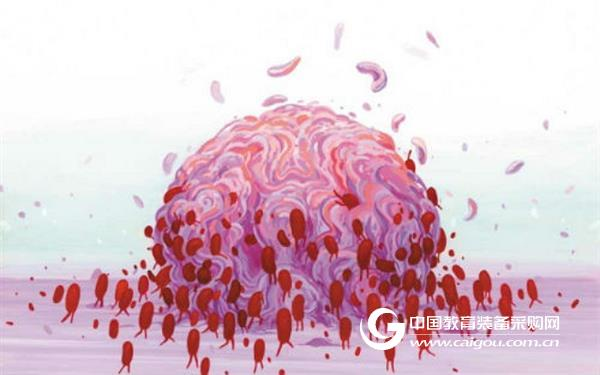Guide
On June 19th, Professor Zhang Can and Professor Mo Ran of China Pharmaceutical University published the latest research results in the journal Nature Nanotechnology, revealing a new strategy against malignant brain tumors: using immune cells to transport anticancer drugs, Penetrate the blood-brain barrier against residual tumor cells. This strategy can inhibit tumor recurrence and prolong the lifespan of cancer-bearing mice.

"Using immune cells to transport anticancer drugs and cross the blood-brain barrier to target residual tumor cells." This is a new strategy developed by the research team from China Pharmaceutical University to fight against malignant brain tumors. They hope that this idea can treat Glioblastomas, a malignant tumor with a lower survival rate. Even after surgical resection, deep infiltrating cancer cells remain in the brain tissue and are prone to recurrence.
Related research results were published in the journal Nature Nanotechnology on June 19, and Professor Zhang Can and Professor Mo Ran of the Institute of Pharmaceutical Sciences of China Pharmaceutical University are co-authors of the article.
Neutrophils: the "best choice" for transporting drugs across the blood-brain barrier
The most critical member of the drug delivery system developed by the research team is neutrophils, a key player in the innate immune system. As one of the most common types of white blood cells, neutrophils have a phagocytic bactericidal function that is responsible for aggregation at the site of injury or inflammation to fight infection.
Previous animal and clinical studies have confirmed that neutrophils can cross the blood-brain barrier. Although such cells do not target glioblastoma, they accumulate at the site of tumor resection to combat post-operative inflammation.
With these characteristics of neutrophils, the team has wrapped the traditional chemotherapy drug paclitaxel with lipids. These special liposomes (PTX) are transfected into neutrophils and injected into three mouse models of glioblastoma cells (surgical treatment has been performed to remove major tumor masses).
The results showed that neutrophils loaded with drug capsules can pass through the blood-brain barrier to reach the tumor resection area under the guidance of inflammatory signals, destroying residual cancer cells, thereby inhibiting tumor recurrence and development. Overall, the life of the treated mice was significantly longer than that of the untreated control group.
New strategy does not completely inhibit tumor growth
This innovative treatment cannot completely prevent the recurrence of tumors. "The mice that survived the neutrophil treatment in the study were not completely cured, and tumor cells were still detected in their brains," Professor Moran stressed.
"Glioblastoma is a very aggressive tumor, and the patient's prognosis is very poor." Professor Johns Hopkins' neurosurgery commented on the study, "We need to jump out of the existing The framework, this research has taken an important step."
Erwin Van Meir, a neuro-oncologist at Emory University, also affirmed that he believes that Zhang Can and Mo Ran's approach utilizes the most abundant class of immune cells in white blood cells, which can collect large numbers of samples from patients' blood. However, in animal experiments, the number of neutrophils used by the team for treatment is 10 times that of normal immune cells in normal mice! This means that the amount of blood required for this treatment strategy in the future may be quite large.
Van Meir also pointed out that the limitation of this study is that the brain tumor models used are all flawed. He explained that two of the models used by the team were not considered good in the field of neuro-tumor research because they showed immune rejection. The third model is based on human glioblastoma cells, and a 2016 study revealed that these cell lines are different from primary tumors. “So, it’s unclear how viable this strategy translates into clinical practice,†Van Meir said.
However, the idea of ​​using neutrophils to cross the blood-brain barrier to transport drugs into the brain is valuable and is expected to be used to treat neurodegenerative diseases as well as other inflammatory brain diseases. "Any disease that recruits neutrophils can be a target for this strategy," Van Meir said.
Professor Moran said that the team is currently actively preparing preclinical trials for neutrophil transport drug systems. He hopes that this treatment strategy is expected to bring some new hope to patients with glioblastoma.
Shanghai Chuangsai Technology has excellent performance, interleukin cytokines, fetal bovine serum, electrophoresis equipment scientific instruments, raw material drug standards, chemical reagents, cell culture consumables, Shanghai Chuangsai, mass products special promotions, welcome to inquire!
Create a cleaner, tidier living room it's very important for your living. Shoe cabinets keep footwear neat, tidy and out of sight. Fold-down cabinet doors open to reveal organized shoe racks and close to create a polished appearance.Save time to search for shoes by organizing your collection in one dedicated storage space. The easy track shoe tower keeps up to 15 pairs of shoes and boots in order, up off the floor, and stored neatly in one place so they`re easy to find and put away. The tower is easy to assemble and can be set on the floor or hung on a heavy-duty steel rail to keep floor space open underneath for additional storage.
Shoes Cabinet,Shoe Cupboard,Shoe Rack Cabinet,Shoe Display Case
Baklam , https://www.baklamjm.com